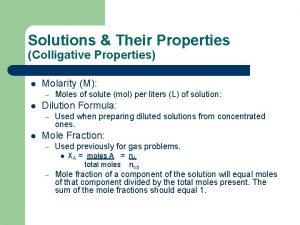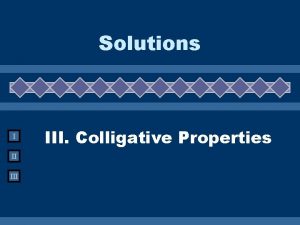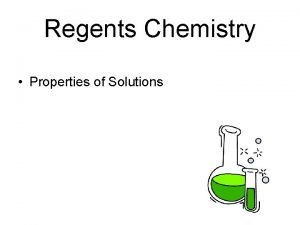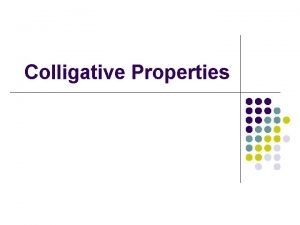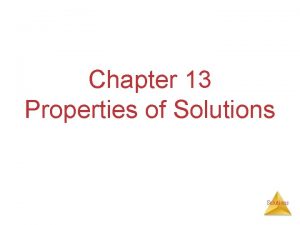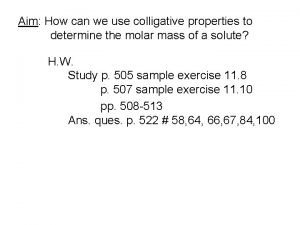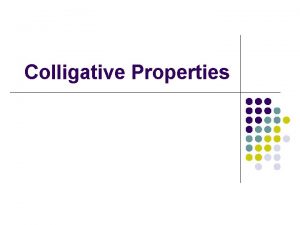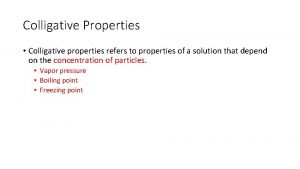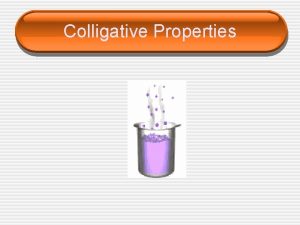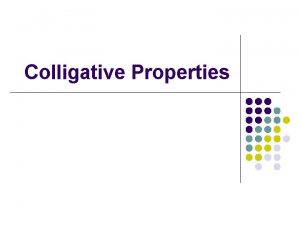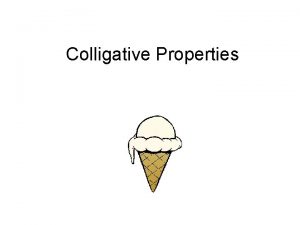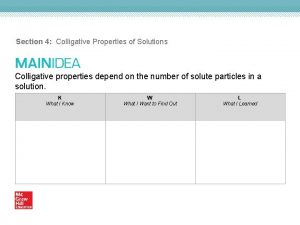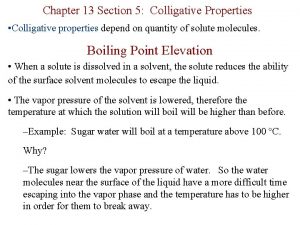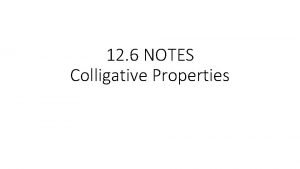Section 13 4 Colligative Properties Colligative Properties In




















- Slides: 20

Section 13. 4 Colligative Properties

Colligative Properties In this section… a. Osmotic pressure b. Vapor pressure lowering i. Distillation c. Boiling point elevation d. Freezing Point depression

Colligative Properties: Properties of the solvent that change upon dissolution of a solute Key #1: This all involves solute particles “blocking” molecules from leaving the liquid state: Key# 2: It does not matter what the solute is, just how many particles (molecules or ions are present)

Osmotic pressure is the amount of pressure required to prevent the flow of a solvent across a semipermeable membrane.

Osmotic pressure: Example

Effect of Ions: i = van’t Hoff factor Ideal Van’t Hoff factors: NH 3 KCl Ca. Cl 2 Fe. Br 3

Osmotic pressure: the van’t Hoff Factor What is the osmotic pressure of a solution containing 0. 249 g Ca. Cl 2 dissolved In 151 m. L of an aqueous solution at 298 K? The van’t Hoff factor in this solution is 2. 8.

Osmotic pressure: the van’t Hoff Factor What is the osmotic pressure of a solution containing 0. 249 g Ca. Cl 2 dissolved In 151 m. L of an aqueous solution at 298 K? What does a van’t Hoff factor of 2. 8 really mean?

Using osmotic pressure to determine molar mass In a laboratory experiment, a student found that a 229. 5 -m. L aqueous solution containing 11. 34 g of a compound had an osmotic pressure of 15. 4 mm Hg at 298 K. The compound was also found to be nonvolatile and a nonelectrolyte. What is the molar mass of this compound?

Vapor Pressure Lowering: The Concept The presence of a nonvolatile solute blocks solvent molecules from escaping to the gas phase. Psolution solvent

Vapor Pressure Lowering: Raoult’s Law Example Psolution = Posolvent x i The vapor pressure of hexane (C 6 H 14) at 50 °C is 399 mm Hg. What is the vapor pressure of a solution consisting of 70. 0 g hexane and 0. 100 mol of a solute that is a nonvolatile nonelectrolyte?

Distillation: Changing the composition of a mixture of volatile liquids Vapor Pressures at 50 o. C Water 99 mm Hg Ethanol 232 mm. Hg Distill a 10% alcohol solution.

Freezing and Boiling Point Changes: The presence of a solute keeps molecules in the liquid phase and therefore extends the temperature range the substance exists as a liquid.

Boiling Point Elevation: An extension of Vapor Pressure Lowering The presence of a solute lowers the vapor pressure, meaning a higher temperature must be reached for the vapor pressure to reach 1 atm.

Boiling Point Elevation

Boiling Point Elevation: Example What is the boiling point of a solution containing 40. 0 g I 2 and 250 g benzene (C 6 H 6)?

Use Boiling Point Elevation to Determine Molar Mass 0. 315 g of an unknown compound (a nonvolatile nonelectrolyte) and 25 g of CHCl 3 has a boiling point of 62. 09 °C. The normal boiling point of CHCl 3 is 61. 70 °C. What is the molar mass of the compound? (Kbp = 3. 63 °C/m for CHCl 3)

Freezing Point Depression

Freezing Point Depression What is the freezing point of a solution containing 40. 0 g I 2, a nonelectrolyte, and 250 g benzene (C 6 H 6)?

Freezing and Boiling Point Changes & Phase Diagrams
 4 colligative properties
4 colligative properties Colligative molarity
Colligative molarity Colligative properties definition
Colligative properties definition Van't hoff factor of nacl
Van't hoff factor of nacl Solutions chemistry regents questions
Solutions chemistry regents questions Colligative properties of milk
Colligative properties of milk Colligative properties examples
Colligative properties examples Colligative properties worksheet
Colligative properties worksheet Vant hoff factor of glucose
Vant hoff factor of glucose Colligative properties
Colligative properties 4 colligative properties
4 colligative properties Colligative properties depend on
Colligative properties depend on Colligative properties sample problems
Colligative properties sample problems 16.3 colligative properties of solutions
16.3 colligative properties of solutions Applications of colligative properties in foods
Applications of colligative properties in foods Air properties calculator
Air properties calculator Freezing point chapter 13
Freezing point chapter 13 Calculating molar mass using colligative properties
Calculating molar mass using colligative properties Colligative properties notes
Colligative properties notes Raoult's law
Raoult's law Applications of molality in pharmacy
Applications of molality in pharmacy

